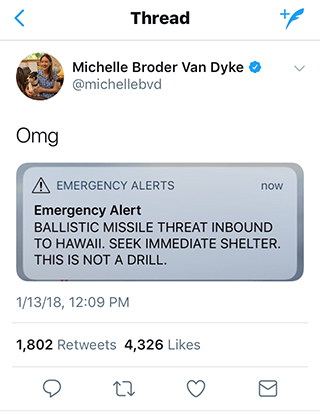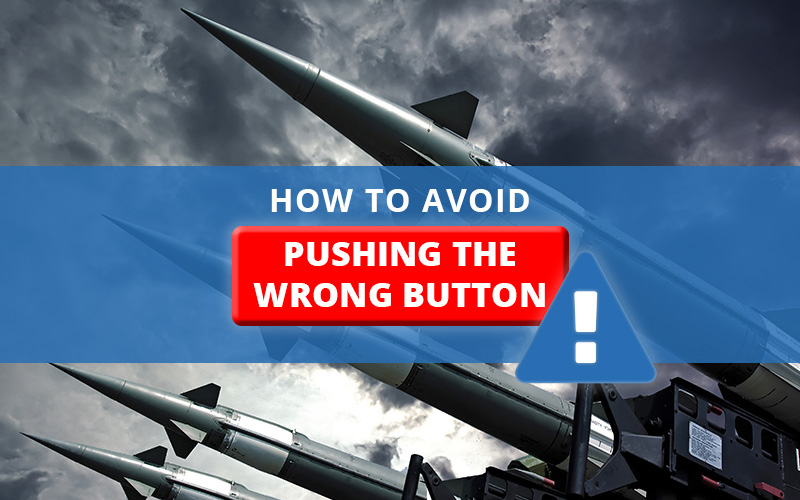When Hawaii emergency management officials mistakenly sent out a ballistic missile warning on Jan. 13, they endangered the lives of Hawaii residents. Upon receiving the alert, residents ran for cover, they sped home to loved ones, they climbed into stormwater drains and they overwhelmed 911 with phone calls. They also took residents and their loved ones throughout the world on an emotional rollercoaster no one should have to endure accidentally. For close to 40 agonizing minutes, many Hawaii residents thought they might die.
 My parents and numerous close friends live in Hawaii. I was checking Twitter on Saturday when I saw Buzzfeed reporter Michelle Broder Van Dyke’s post: “OMG” with a screenshot of the emergency alert pushed out to mobile phones across the state. “Emergency Alert: Ballistic Missile Threat Inbound to Hawaii. Seek Immediate Shelter. This is not a drill.” Luckily, upon scrolling further, I saw U.S. Rep. Tulsi Gabbard’s tweet “Hawaii – This is a false alarm.”
My parents and numerous close friends live in Hawaii. I was checking Twitter on Saturday when I saw Buzzfeed reporter Michelle Broder Van Dyke’s post: “OMG” with a screenshot of the emergency alert pushed out to mobile phones across the state. “Emergency Alert: Ballistic Missile Threat Inbound to Hawaii. Seek Immediate Shelter. This is not a drill.” Luckily, upon scrolling further, I saw U.S. Rep. Tulsi Gabbard’s tweet “Hawaii – This is a false alarm.”
Hawaii’s governor said that the alert went out after an employee at Hawaii’s Emergency Management Agency intended to conduct an internal drill but “pushed the wrong button.” Oops.
Luckily in email marketing, we rarely deal with messaging as critical as incoming missile warnings. But there are plenty of us who announce weather-related school and business closures, security-related lockdowns, urgent traffic notifications and other crisis communications that – if sent without care – could spark unnecessary panic or stress. If an agency tasked with keeping citizens safe can push the wrong button, how can we avoid doing the same with our important announcements, newsletters and even sale emails?
There are definitely a few lessons that can be learned from the mishap in Hawaii.
What the Hawaii Mishap Teaches Us
Use plain, descriptive language when naming lists and campaigns.
As it turns out, the difference between conducting a drill and sending a statewide emergency notification was selecting the wrong file from a list. “DRILL-PACOM (DEMO) STATE ONLY” was the file that should have been selected for a drill. “PACOM (CDW) – STATE ONLY” fired the real emergency alert. These file names were sandwiched between several other acronyms that further contributed to the confusing alphabet soup of options. Without documentation, which file would you select for an incoming ballistic missile drill? A better name would have been “DRILL-Ballistic Missile Strike” and “LIVE ALERT-Ballistic Missile Strike.”Do you have lists and campaigns saved in your email service provider account with confusing names? Time to use plain descriptions as file names. It’s also a good idea to remove old lists and campaigns you never plan to use again.
Document the email sending process and use a QA checklist!
No email – or any other type of mass communication – should be deployed before a quality assurance checklist has been completed. This helps ensure mistakes aren’t made and opportunities aren’t missed. What should be on your checklist? For email, you’ll want to confirm the recipient list is correct, the subject line is clear and correct and that the email looks good in all the major email inbox providers (Gmail, AOL, iPhone mail app, for example). Are your links working? Are dates, times and offer details all correct? Has someone proofread for typos? Have the necessary people reviewed and approved the email? At Katey Charles Communications, we follow a 40-plus point checklist before pushing send on any email.
Practice responding to a mistake.
Let’s say you are a school district and you accidentally clicked “send” while reviewing a draft email announcing that a particular school is on lockdown. If that message hits inboxes, you’ll have hundreds of anxious parents texting their kids or grabbing their car keys to head to school. It’s critical that you practice what to do next to mitigate the anxiety caused by a false alarm. Craft an “emergency mistake plan” that includes details on how to cancel the message and what to do if you can’t cancel it. Often, the best course of action is to send a correction and apology email ASAP. In your plan, identify anyone who needs to approve your apology email, and make sure they are available in the event of a mistake for a quick review. To save time, it’s best to draft an apology email and have it prepared in advance so that all you have to do is update a few details and click send. In many cases, one standard apology email could be updated to cover a lot of different scenarios. You may also want to practice using your email service provider’s platform from your mobile device.
For those who don’t send emails related to crisis communications, it’s still important to understand how to correct mistakes and to practice doing so. For example, did you know you can often change links and update images AFTER an email is deployed? You can also cancel emails that are throttled to send a maximum volume per hour, which can keep some of the incorrect emails from hitting the inbox.
One thing is certain, accidents happen. However, if you practice good file- and list-naming protocols, use quality assurance checklists and prepare a mistake response plan, you can reduce your chances of making a major mistake and be prepared to respond quickly in the event you do. This should lessen some of the anxiety associated with the send button, although as someone who has worked in this industry for many years, I’ll tell you that anxiety never totally goes away.
Need help managing your lists and creating a quality assurance process to prevent email mistakes? We can help. Call us 314-918-8088 or email .

